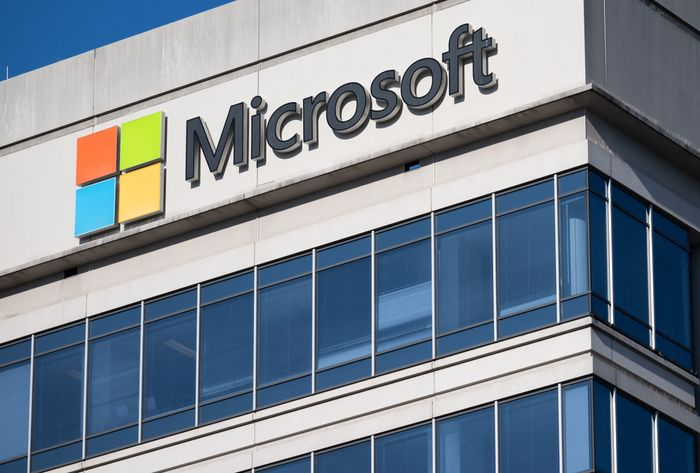Microsoft suggests sales in the current quarter will come in at least $1 billion lower than Wall Street expected as December slowdown is projected to continue into new year, gains of 4% and disappear in after-hours trading

Microsoft Corp.’s profit declined more than 12% in the holiday season, and executives said Tuesday that a revenue deceleration in December is expected to continue into the new year as the company lays off workers.
Microsoft reported fiscal second-quarter earnings of $16.43 billion, or $2.20 a share, a decline from $2.48 a share a year ago. The company also reported that severance, impairment and lease-consolidation costs cost it 12 cents a share, which would lead to adjusted earnings of $2.32 a share; Microsoft executives did not provide adjusted earnings a year ago, and typically stick to GAAP profit readings.
Revenue increased to $52.75 billion from $51.7 billion in the holiday quarter of 2022. Analysts on average expected earnings of $2.29 a share on sales of $52.99 billion, according to FactSet.
For the current quarter, Microsoft executives expect revenue of $50.5 billion to $51.5 billion, according to guidance provided by Chief Financial Officer Amy Hood in a conference call Tuesday afternoon. Analysts on average were expecting fiscal third-quarter revenue of $52.42 billion, according to FactSet.
Hood said that Microsoft observed a slowdown in customer spending in December, and expects that to continue. Azure grew by 38% in constant currency, topping expectations, but Hood said that they exited December in the “mid-30s” after the deceleration, and executives expect that percentage to fall four or five points in the current quarter. Analysts were projecting Azure growth of 27.8% for the quarter, or 33.7% in constant currency, according to FactSet.
Microsoft shares gained more than 4% in after-hours trading immediately following the release of the results, but they began to drop after the forecast and December deceleration news were shared. The stock was down 1% as of 8:00 p.m. Eastern.
Microsoft’s forecast takes on extra importance this quarter, as analysts believe that businesses slowed down deals at the end of 2022 to cut costs and for other reasons, and Wall Street will want to know if Microsoft expects any deals that didn’t close before the end of the year will be included in the current quarter’s results. Microsoft executives told investors at the end of the last fiscal year that they expect double-digit percentage growth in revenue and operating margins, but a lot has happened since then.
Microsoft announced thousands of layoffs last week, part of a wave of job cuts from Big Tech companies that increased their workforces at a rapid pace in the early years of the COVID-19 pandemic. Wall Street analysts believed the move signaled concerns about revenue growth.
“We expect that the head-count reduction announcement … will likely be accompanied by a lower revenue outlook for the second half of the FY, but the actions taken by the company are an illustration of how Microsoft can dynamically adjust its cost base to preserve EPS and free cash flow given the macro choppiness,” Evercore ISI analysts wrote in a preview of the earnings, while maintaining an outperform rating and $280 target price on the stock.
Microsoft executives hope to provide a rosier outlook with other deals. The day before its earnings report, the company officially announced a long-expected third investment in ChatGPT creator OpenAI, which includes plans to incorporate the technology into services such as Microsoft’s Azure cloud-computing offering and Bing search engine. Microsoft is also still in the process of acquiring videogame-publishing giant Activision Blizzard Inc. for $69 billion, though it is facing pushback from regulators worldwide.
“We are particularly keen for updates on this deal, and would pay special attention to what sorts of concessions Microsoft is prepared to make at this point, and at what point the concessions make the deal unattractive to shareholders,” Macquarie Research analysts wrote of the Activision acquisition, while maintaining a neutral rating but decreasing their price target to $232 from $234.
Microsoft reported cloud revenue of $21.5 billion, up from $18.33 billion a year ago and narrowly topping the average analyst estimate of $21.43 billion, according to FactSet. Azure grew 31%, while analysts on average were expecting 30.5% growth from the cloud-computing product; Microsoft does not provide full revenue or profit figures for Azure, even though Amazon.com Inc. and Alphabet Inc. provide such results for their rival cloud products.
Microsoft’s personal-computer segment recorded $14.2 billion in revenue, down from $17.47 billion in the previous holiday season and missing the average analyst estimate of $14.76 billion. PC shipments suffered their worst decline ever recorded in the holiday season, according to third-party analyses, after a boom in PC sales during 2020 and 2021.
Microsoft’s enterprise-software business had sales of $17 billion, up from $15.94 billion a year ago and beating the FactSet analyst consensus of $16.79 billion.
Microsoft shares have declined 18.4% in the past 12 months, as the S&P 500 index has dropped 8.9% and the Dow Jones Industrial Average — which counts Microsoft as one of its 30 components — has declined 2.1%.

